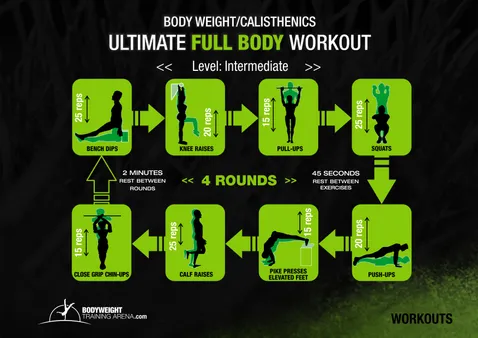Table of Contents
calisthenics strength training is a great way to get in shape without having to go to a gym or use any equipment. It's a bodyweight training method that uses your own body weight as resistance. This makes it a very portable and accessible form of exercise. Calisthenics strength training can help you build strength, endurance, and flexibility. It's also a great way to improve your balance and coordination. In this article, we'll discuss the benefits of calisthenics strength training, how to get started, and some exercises and workouts you can try. Whether you're a beginner or an experienced athlete, calisthenics strength training is a great way to improve your overall fitness. Kizworld
Master the Art: Unlocking Powerful Calisthenics Strength Training
Benefits of Calisthenics Strength Training | How to Get Started with Calisthenics Strength Training |
|---|---|
Increase strength | Start slowly |
Build muscle | Warm up properly |
Improve endurance | Use proper form |
Enhance flexibility | Listen to your body |
Boost metabolism | Be patient |
Burn fat | Find a buddy |
Improve balance | Join a class |
Strengthen core | Work out regularly |
I. Benefits of Calisthenics Strength Training
Improved Physical Fitness
Calisthenics strength training offers a comprehensive workout that engages multiple muscle groups simultaneously. It helps build strength, increase endurance, and enhance flexibility. By utilizing bodyweight as resistance, calisthenics exercises challenge the body in a natural and functional way, leading to improved overall physical fitness.
Increased Strength and Muscle Mass
Calisthenics exercises progressively overload the muscles, forcing them to adapt and grow stronger. Over time, this leads to increased strength and muscle mass. Compound exercises like pull-ups, push-ups, and squats work for multiple muscle groups, maximizing efficiency and promoting balanced muscle development.
Exercise | Muscles Targeted |
|---|---|
Pull-ups | Back, biceps, shoulders |
Push-ups | Chest, triceps, shoulders |
Squats | Legs, glutes, core |
Enhanced Flexibility and Mobility
Calisthenics exercises often involve dynamic movements that stretch and mobilize the joints. By incorporating exercises like leg swings, arm circles, and shoulder rolls into your routine, you can improve flexibility, reduce muscle tension, and enhance your range of motion.
Improved Body Composition
Calisthenics strength training can aid in weight loss and body fat reduction. The combination of strength building and cardiovascular elements helps boost metabolism and burn calories. By increasing muscle mass, calisthenics also supports a leaner body composition.
Reduced Risk of Chronic Diseases
Regular calisthenics strength training has been linked to a reduced risk of chronic diseases such as heart disease, stroke, and type 2 diabetes. By improving cardiovascular health, maintaining a healthy weight, and reducing inflammation, calisthenics can contribute to overall well-being and longevity.
Improved Mood and Cognitive Function
Exercise, including calisthenics, has been shown to release endorphins, which have mood-boosting effects. Additionally, the physical and mental challenges of calisthenics can improve cognitive function, enhance focus, and reduce stress levels.Discover more benefits of calisthenics for bodyweight training
Related Posts:
- How to Get Started with Calisthenics as a Beginner
- The Best Calisthenics Exercises and Variations
- How to Build Muscle and Strength with Calisthenics
Benefits of Calisthenics Strength Training
II. Essential Calisthenics Exercises for Strength Building
Push-ups
Push-ups are a classic calisthenics exercise which can be used in a number of ways to build strength, depending on the variation practiced. For example, by placing your hands closer together, more of the focus shifts to your triceps, or by raising your hands elevation higher than your feet, you increase the load on your shoulders. Check out How to do a Push-Up to know about different push-up variations, the benefits, common mistakes, and tips.
- Standard push-ups
- Incline push-ups
- Decline push-ups
- Diamond push-ups
- Wide push-ups
Pull-ups
Pull-ups are another foundational exercise worth including in any strength-building routine. This exercise primarily targets the back muscles but can also help you develop strong biceps and forearms. Like push-ups, there are many ways to modify pull-ups to make them more challenging or easier, such as by adjusting the grip width or using an assist band. For comprehensive guidance on pull-ups, you may find How to Do a Pull-Up helpful.
- Standard pull-ups
- Chin-ups
- Neutral-grip pull-ups
- Wide-grip pull-ups
- Close-grip pull-ups
Squats
Squats are an excellent exercise for building strength in your legs and glutes. They involve bending your knees and hips to lower your body down, then pushing back up to the starting position. As with other calisthenics exercises, there are numerous squat variations that can be done without any equipment. How to Do a Squat can give you a good idea on how to perform the basic squat and some of its variations without weights.
- Bodyweight squats
- Bulgarian split squats
- Pistol squats
- Jump squats
- Squat jumps
Essential Calisthenics Exercises for Strength Building
III. Training Schedule and Progression Plan for Calisthenics Strength Development
Consistency is key when it comes to calisthenics strength training. Aim to work out at least 3 times per week, with each session lasting around 30-60 minutes. As you progress, you can gradually increase the frequency and duration of your workouts.
It's important to start slowly and gradually increase the difficulty of your workouts over time. This will help you avoid injuries and ensure that you're making progress at a sustainable pace. Listen to your body and take rest days when needed.
Here is a sample training schedule for calisthenics strength development:
Day | Exercises | Sets | Reps |
|---|---|---|---|
Monday | Pull-ups, push-ups, squats, lunges | 3 | 10-15 |
Tuesday | Rest | - | - |
Wednesday | Dips, rows, planks, calf raises | 3 | 10-15 |
Thursday | Rest | - | - |
Friday | Muscle-ups, handstand push-ups, weighted squats, plyometrics | 3 | 10-15 |
Saturday | Rest | - | - |
Sunday | Active recovery (e.g., yoga, swimming, walking) | - | - |
As you progress, you can increase the difficulty of your workouts by adding weight, increasing the number of sets and reps, or trying more advanced exercises. It's also important to incorporate variety into your workouts to keep things interesting and challenge your body in different ways.
Here are some tips for creating a calisthenics strength training progression plan:
- Start with a beginner-friendly routine and gradually increase the difficulty as you get stronger.
- Focus on compound exercises that work multiple muscle groups at once.
- Use proper form and technique to avoid injuries.
- Listen to your body and take rest days when needed.
- Be patient and consistent with your training.
With dedication and hard work, you can achieve your calisthenics strength training goals. Just remember to be patient, consistent, and listen to your body.
Here are some related posts that you may find helpful:
- How to Get Started with Calisthenics as a Beginner
- The Best Calisthenics Exercises and Variations
- How to Design Your Own Calisthenics Routine and Program
Training Schedule and Progression Plan for Calisthenics Strength Development
IV. Nutritional and Lifestyle Considerations for Maximizing Calisthenics Strength Results
In addition to following a consistent calisthenics training program, optimizing your nutrition and lifestyle habits plays a crucial role in maximizing your strength development. Here are some key nutritional and lifestyle considerations to keep in mind:
Nutrition:
- Protein intake: Protein is essential for muscle growth and repair. Aim for a daily protein intake of 1.6-2.2 grams per kilogram of body weight.
- Carbohydrate intake: Carbohydrates provide energy for your workouts. Consume a mix of complex and simple carbs throughout the day, with a focus on whole grains, fruits, and vegetables.
- Hydration: Staying hydrated is crucial for overall health and performance. Drink plenty of water throughout the day, especially before, during, and after your workouts.
Lifestyle:
- Sleep: Aim for 7-9 hours of quality sleep each night. Sleep is essential for muscle recovery and growth.
- Stress management: Chronic stress can interfere with muscle growth and recovery. Find healthy ways to manage stress, such as exercise, meditation, or yoga.
- Alcohol and smoking: Limit alcohol consumption and avoid smoking. These substances can negatively impact muscle growth and recovery.
Nutrient | Recommended Intake |
|---|---|
Protein | 1.6-2.2 grams per kilogram of body weight per day |
Carbohydrates | 4-6 grams per kilogram of body weight per day |
Fats | 1-1.2 grams per kilogram of body weight per day |
By following these nutritional and lifestyle guidelines, you can create an environment that supports optimal calisthenics strength development and helps you achieve your fitness goals.Here are some additional tips to enhance your calisthenics strength training results:
- Practice regularly.
- Start slowly and gradually increase the intensity and duration of your workouts.
- Use proper form to avoid injuries.
- Listen to your body and take rest days when needed.
- Find a workout buddy or group to stay motivated.
With dedication and consistency, you can achieve your calisthenics strength goals and unlock your fitness potential!Related Posts:
- Calisthenics: The Ultimate Guide to Bodyweight Training
- The Benefits of Calisthenics for Bodyweight Training
- The Best Calisthenics Exercises and Variations
Nutritional and Lifestyle Considerations for Maximizing Calisthenics Strength Results